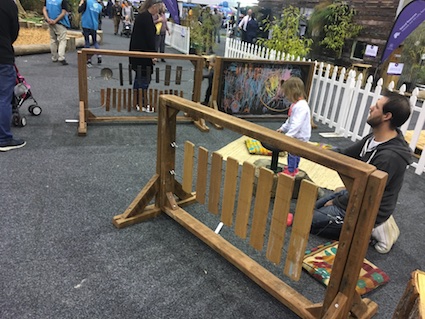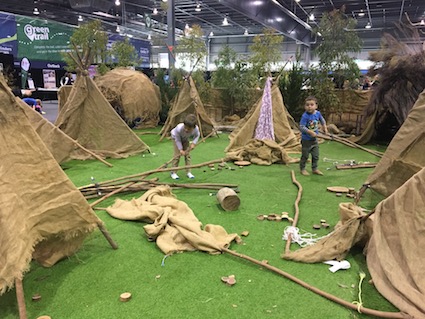
When in Adelaide, I was fortunate enough to be able to visit the World Environment Fair. It’s an indoor event with lots of stalls and information about all things environmental. As soon as you enter, the first thing that was to be seen was a huge – and I mean HUGE – natural play space for children. It’s common to have pop up play spaces full of junk loose parts, but creating a temporary pop up natural playground is something else. The company who provided this is The Climbing Tree founded by Simon Hutchinson.

Now, I am not advocating indoor nature play spaces. I remain firmly in the “outdoors is best” camp as it is the interplay between the earth and sky which makes for a unique and special experience that is constantly changing. The weather and seasons interact with nature play spaces in a way that cannot be replicated inside.

What I really liked about this area is that it demonstrates possibilities for concrete jungles and schools and early years settings where it is not possible or permissible to dig up the asphalt. The option becomes creating play spaces on top of this. Again, I am not suggesting this is either good or bad but it’s the state of play for some schools. As you can see in all the photos, this natural play space has been created on carpet.

The second sandpit had various logs for children to stand on, balance and play. If you look carefully through the photos, you will see a lot has care has gone into its creation. It was a hive of activity with the younger children who loved all the natural loose parts. In particular, the fairy houses created from hollow trunks were particularly popular.

As well as being individual, beautiful and decorative, the houses were also extremely strong and stable. I saw more than one child go around and try and balance on each one.

The whole area made me realise that it’s provides lots of tips for doing something similar. Firstly, look at the musical instruments and blackboards. They are on robust self standing panels. This means they can be accessed from both sides. They can can also be used to create zones outside, as an alternative to long planters.

For den building, it’s useful to have lots of long poles – at least 150cm in length. This may seem excessive but it does mean that the dens can house children as opposed to teddy bears. Whilst hessian has been used for this play space, bear in mind it’s indoors. Outside, go for quick dry material that won’t take hours to dry if it gets wet during inclement weather. You can learn how to create quick dens by weaving the poles together with rope. These will stay up especially if you add more strength by lashing the poles together at the base.

The Climbing Tree makes beautiful huts, domes and stick cubbies. Each provided a very different experience owing to the materials used and the amount of light that could get through the walls. Some are ideal for further weaving and decorative work.

Whilst it wasn’t part of the nature playground, I also loved this straw bale, decking and weaving platform…

Good ideas gathered from this pop up nature playground
- Go as big as you dare. Both sand pits and the other two play spaces were spacious. Children didn’t need to queue or wait to play. There was enough room for all.
- Protect your surface. Underneath the sand was matting to avoid the carpet being ruined.
- Think about your zones and what children like to do. One sand pit contained lots of space that focused on the sand rather than added loose parts. The play was consistently different in this pit to the other sandpit with lots of loose parts. It was much more about the sculpting of the sand and creating mounds, channels and holes. The older children were hanging out on the big log and swing.
- Go for abundance and diversity. In one sandpit there were lots of logs of different shapes, sizes, lengths and species. Some were hollow. Some had bends. Some had rough bark, others smooth. It meant that each one fuelled the imagination in different ways and provided textures and explorations in a way that homogeneity does not. Likewise consider the range of plants which can be grown in containers to add year round interest, beauty and play value.
- Have a little kitch. Children loved the fairy houses. These added beauty, intrigue and value. If your children have particular fascinations then go with their flow.
- Make the edges part of the design. The edges of the sandpit added immense value to the play spaces. Look in the photos to see the logs all at different heights. Some of the logs were placed horizontally. Children moved along, over and around the edges. Adults found a place they liked to sit.
- Go tough. Make everything as robust as possible. Imagine how many children will be playing in that space all year round, in all weathers. It has to last through high levels of play.
- Avoid wobbles. All the edging logs, tree trunks and other features were very secure. They didn’t wobble and move when children played on them.
- Care lots. You cannot do anything outside and expect it magically to look after itself. You need to have maintenance calendar in place so that you know what daily, weekly and monthly jobs need to happen to keep the area going. This could be things like sweeping the sand daily, weeding container plants weekly and topping up the loose parts monthly. This pop up play space had Simon and other volunteers to facilitate the play.
- Keep the play going. Have a look at the Climbing Tree website for some of the features which you may miss in this blog post. There were all sorts of interesting bits and bobs to keep the play going such as a rock grinding wooden bowls, wooden channels and wood cookies etc. Simon runs all sorts of incursions and support to help get local organisation get started.
- Be good. Be thorough. Stay safe. Thorough planning is vital. Remember to check in advance and get all the necessary permissions from the people and organisation that have a vested interest and responsibility for your outdoor space. Do all the necessary preparation including consulting children. Risk benefit both the installation and the ongoing use of the space.

2021 Update. I loved this approach so much, that in 2018-19 I worked with Middleton Park Primary School and Nursery to apply the concept to an outdoor play space using a participatory approach. Have a look at the case study of we did this here including videos made by children and staff:
- The case study – this is a good summary
- Developing outdoor spaces
- The construction video
- The evaluation video
Also enjoy the video made in Sept 2020 which shows that with love and care, the playspace can be heavily used.
This blog post was originally published in June 2018.



















